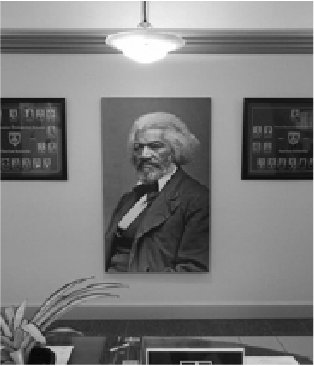Disparities in Financial Aid Access: Breaking the Bank

April 26, 2016
When Ellen first came to American University, she hit the ground running. The women’s studies and politics double major immersed herself in campus organizations like Students Against Sexual Violence and Women’s Initiative. By her sophomore year, Ellen, who asked to remain anonymous, had landed a job at the Rape & Incest National Network.
“I felt like I was really coming into myself at AU,” she says.
Ellen was the first in her family to go to college, and her parents took out loans to help supplement her AU grant and partial Frederick Douglass scholarship. But last spring’s tuition hike, along with a cut in her financial aid, forced Ellen to put her AU career on hold.
“When I found out I couldn’t come back, it was heartbreaking,” Ellen says.
Ellen moved back in with her parents in New Jersey to work. She’s hoping to save enough money to return to AU next fall. On a recent visit back to DC, she says, “It was really hard seeing my friends…I’d forgotten how much I enjoyed taking classes and learning.”
***
Ellen’s story sheds light on a host of interconnected problems that students like her—first-generation, low-income people of color—face. Students of color are more likely to rely on student loans, according to public policy think tank Demos, and nearly four in 10 low-income borrowers drop out of college. According to the National Center for Education Statistics, first-generation students are more likely to be of color and to come from low-income families and are more likely to drop out than their continuing-education peers.
Robert Kelchen, a professor in Seton Hall University’s education department who studied the disproportionate reliance on student loans among black families, says that one of the reasons for this disparity is that people of color are more likely to lack family wealth.
“Family income is how much money a family makes during a given year, while wealth refers to their total level of resources,” Kelchen wrote in an email. “Black families tend to have less wealth because they have made less money than white families for generations. The cumulative effect of higher incomes for the average white family results in the wealth disparities.”
Kelchen says slavery and widespread employment discrimination are examples of the ways that black families have historically been prevented from accumulating as much wealth as white families.
Latino families are also more likely to have a disproportionate lack of wealth.
“In the aftermath of the recession, whites held 13 times more wealth than Black households and 10 times more wealth than Latino households,” says Demos researcher Mark Huelsman.
***
Sydney Young, a sophomore in the School of Public Affairs, says she’s thought about dropping out. Her parents had to move from their house to a small apartment so that they could support her. Her father, a corrections officer, started driving an Uber to make extra money. Still, Young expects to be nearly $100,000 in debt by the time she graduates.
“[My parents] want me to do well in school, so it’s worth them paying the loans,” Young says. “They’re very sacrificial: ‘If you do well in school, get that job you want, then it’s worth us being in debt.’”
Given the competitive job market, however, Young says she’s under a lot of pressure.
“It makes me feel bad because I don’t want my parents to work until they can’t work anymore to pay for something that may not even be lucrative in the end,” she says.
When it comes to entering the workforce, the odds are stacked against people of color. In the Washington metropolitan area, for example, the unemployment rate for African Americans is nearly double that of Caucasians, according to a study by the Economic Policy Institute.
Young’s loans were the first that her parents had ever taken out, and there was a steep learning curve.
“We’d never done anything like that before,” she says. “I feel like we weren’t educated in the process, and it makes us even more paranoid about it.”
For Young, the process of taking out loans was so protracted that she wasn’t able to register for her first semester until after classes started. First-generation families like hers, Young says, need more resources to make up for the financial literacy they often lack.
Roshni Sharma, a freshman in the School of International Service, says that her parents obtained higher education—her father got his associate degree in the U.S. after moving from India, and her mother got her master’s degree in India. Yet when it came to getting financial aid for their daughter, they were as mystified as she was.
“My parents didn’t have a lot of schooling here, so I had to get all my information from my cousins who were older than me,” Sharma says. “Even now, it’s pretty coded in a lot of big words.”
***
When asked if AU’s financial aid resources had been helpful to her, Ellen laughs.
“If you talk to anyone who has ever been to the financial aid office, it’s six different headaches every time you go in,” she says. She recalls receiving her first bill as she was preparing to come to AU as a freshman. It was $2,000 more than the amount she’d thought she would have to pay—the financial aid office had forgotten to include her meal plan in her initial acceptance letter, and her family was left scrambling to scrape up the extra money.
When she called the financial aid office, she says that the staff wasn’t very understanding.
“For some of the students, maybe that wouldn’t be a problem,” Ellen says. “But I think there’s a fair amount of students at AU that that’s a huge issue for—even coming up with 500 extra dollars is an issue.”
Ellen would have felt better “if someone would have been more understanding of my situation, had tried to work with me, as opposed to telling me ‘I don’t know what to tell you—you’re going to have to figure out where to get that money from.”
Sharma says that even with financial aid and loans, the cost of attending AU for a year nearly matches her parents’ annual income. When Sharma visited for Freshman Day, she went to the financial aid office to ask if there was any way that she could get more aid.
“Before I even finished the sentence, they were like, ‘We can’t do anything,’” she says.
***
“When I hear stories like that, it breaks my heart,” says Shirleyne McDonald, Associate Director of the Financial Aid Office. “There are so many different trainings and conversations that we have to ensure that all of our students feel supported and that all of our staff understand that when you speak to a student, you’re representing the institution…So even though you may have said it five other times to five other families, for the one in front of you, this is their first experience.”
Brian Lee Sang, the director of the financial aid office, says that many staff members from the financial aid office and AU Central have undergone voluntary customer service training from AU’s human resources department.
“The university is very focused and sensitive toward providing good customer service to students,” Sang says. However, he acknowledges that “sometimes [students’] perception doesn’t work out as well as we’d hope.”
Both McDonald and Sang were first-generation students themselves, and they understand the anxiety that students have about financing their education. Sang says the office’s capacity to support underserved students has improved since he started in 2000.
“For many, many years I put forth proposals to try and change the funding structure here at AU,” he says. When he came on board, for example, the majority of AU’s scholarship resources went to merit scholarships instead of need-based scholarships.
“That certainly brought the profile of AU up,” he says. “It made us get really high in the rankings. But to me, it was closing off access to students—students of color in particular, and needy students.” Eventually, the university switched to a funding structure in which the majority of resources went toward need-based scholarships.
While Sang and McDonald recognize that students of color are disproportionately challenged when it comes to paying for college, they cannot legally award aid on the basis of race, so they must find other ways to assist underserved students. The Frederick Douglass Distinguished Scholars program, for example, gives preference to both first-generation students and students who are committed to working in communities of color.
Sang says that changing the Pell grant strategy also helped AU support students of color. Pell grants, which are federal need-based awards for students from low-income families, can be the deciding factor when it comes to success for students of color. Researchers at Clemson University found that the graduation rate among low-income African American students who received a Pell grant was 12 percent higher than for those who did not. Among low-income Latino students, the difference was 20 percent.
“We knew a couple of years ago that Pell students in general were almost predominantly students of color,” Sang says. Since he started pushing the university to take on more Pell students, he says, AU has nearly doubled its Pell population.
Another recent improvement, McDonald says, was creating AU Central. The old system was so complicated that it was nicknamed “the Bermuda Triangle.”
“You had to go to so many different offices, and sometimes it felt like you got lost in the middle,” McDonald says. AU Central was created to streamline the student services network, and the Office of Financial Aid works with AU Central’s staff to ensure that they’re well-informed. She says that for about 80 percent of the student population, the new system works. But for those who aren’t satisfied with the answers they get from AU Central, the Office of Financial Aid has a counselor on call.
***
According to Sang, the university does require online entrance counseling for students who take out loans. They experimented with holding mandatory sessions in person, but those sessions were “very sparsely attended,” and ended up placing too much of a burden on students with busy schedules.
Although the office offers a variety of workshops geared toward financial literacy, McDonald says the staff struggles to publicize these events to students. They have tried using TodayAtAU, the Eagle and working with their campus partners like the Office of Campus Life and AU Student Government, but she says that despite these efforts there is a “disconnect” between the way students view the office and the way she wants the office to be seen. She hopes students will reach out to her if they aren’t receiving the help they need.
“We’re all invested,” she says. “We all want to see our students do well. And I don’t know how to make that translate.”
***
At the end of the day, financial stress carries a significant emotional burden for low-income students. Ellen says she know how frustrating it is to always worry about money.
“Take advantage of everything that AU has to offer,” she advises other students. “Since you’re already in debt and you’re already paying so much money, take advantage of every free thing.”


